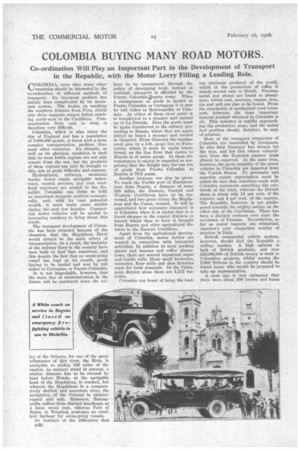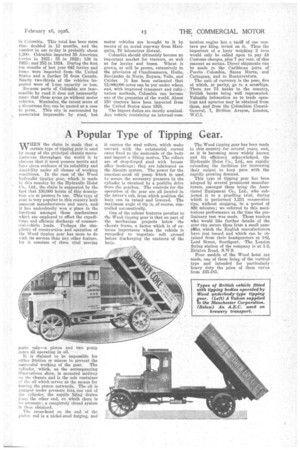COLOMBIA BUYING MANY ROAD MOTORS.
Page 14

Page 15

If you've noticed an error in this article please click here to report it so we can fix it.
Co-ordination Will Play an Important Part in the Development of Transport in the Republic, with the Motor Lorry Filling a Leading Role.
riOLOMBIA, more than many other countries should be interested in the co-ordination of different methods of transport. Its transport problem has mainly been complicated by its mountain system. The Andes, on reaching the southern frontier from Peru, divide into three separate ranges before reaching north-west to the Caribbean. Communication from east to west is therefore very difficult. • Colombia, which is nine times the size of England and has a population of 7,000,000 people, is faced with a mom complex transportation problem than most other countries. Its -climatic, as well as its physical, condition is such that its most fertile regions are not only remote from the sea, but the products of these regions can only be brought to ship side at great difficulty and expense.
Hydroplanes, railways, mountain tracks, motor roads, navigable waterways, coastal services, and even overhead • ropeways are needed in the Republic. Colombia can claim to hold an important stragetic position economically, and, with its vast potential wealth, it mast make great strides during the. next few decades. Commercial motor vehicles will be needed in increasing numbers to bring about this result.
The transport development of Colombia has been retarded because of the obsession that the Magdalena River would always be the main artery of transportation. As a result, the majority of the railway lines in the country have been built to feed that waterway,and this despite the fact that no ocean-going vessel' can load at its mouth, goods having to be landed and sent by rail either to Cartagena or Puerto Colombia.
It is not improbable, however, that the main line of communication in the future will be eastwards down the val Icy of the Orinoco, for one of the great tributaries of this river, the Meta, is navigable to within 100 miles of the capital. As matters stand at present, a similar distance has to be covered by land before Honda, at the navigable head of the Magdalena, is reached, but whereas the Magdalena is a comparatively shallow and uncertain river, the navigation of the Orinoco is uninterrupted and safe. Moreover, Barranquilla suffers from distinct handicaps as a large ocean port, whereas Port of Spain, in Trinidad, possesses an excellent harbour for ocean-going vessels.
An instance of the difficulties that have to be encountered through the policy of developing local, instead of national, transport is afforded by the Puerto Colombia-14ogota route. When a o ot goods is landed at Puerto olombia or Cartagena it is sent by rail either to Barranquilla or Cainmar. At either of these river ports it is transferred to a steamer and carried up to La Dorada. Here the goods must be again transferred to the railway proceeding to Honda, where they are again placed on board a steamer and carried to Girardot. From Girardot the consignment goes by a 3-ft. gauge line to Facetativa, where it must be again transferred, as the line from that centre to Bogota is of metre gauge. In these circumstances it cannot be regarded as surprising that the freight rate for one ton of goods from Puerto Colombia to Bogota is 78.5 pesos.
Another instance can also be given. To reach the Pacific port of Buenaventura from Bogota, a distance of some 300 miles, the Eastern, Central and Western Cordilleras have to be. traversed, and two great rivers, the Magdalena and the Cauca, crossed. It will be appreciated how necessary transport is to Colombia when it is stated that it is found cheaper in the coastal districts to import wheat than to have it brought from Bogota and other agricultural districts in the Eastern Cordillera.
Apart from the agricultural development of Colombia, motor lorries are wanted in connection with industrial activities. In addition to meat packing plants and banana • and coffee plantations, there are several important sugar and textile mills. Many small breweries, tanneries, flour mills and shoe factories cater for local demands. In the Cartagena district alone there are 1,212 factories.
Colombia can boast of being the lead
ing platinum producer of the world, whilst in the production of coffee it stands second only to Brazil. Precious metal and stones are found in abundance, whilst coal, mercury, copper, iron, tin and salt are also to be found. From the standpoint of mechanical road trans. Port, however, the most important mineral product obtained in Colombia is oil. This industry is rapidly approaching the productive stage, and the motor fuel problem should, therefore, be easy of solution.
Most of the transport companies of Colombia are controlled by foreigners. In this field Germany has always led the way, and for this reason competition from the Teutonic quarter must always be expected. At the same time, however, the great majority of the motor vehicles in Colombia are imported from the United States. To proximity and superior export organization must be added the fact that American trade with Colombia represents something like twothirds of the total, whereas the British share is about only 14 per cent, of the imports and 4 per cent, of the exports., The Republic, however, is not predisposed towards the mighty nation on the other side of the Caribbean. There has been a distinct coolness ever since the severance of Panama. Nevertheless, so far as motor imports are concerned, America's only competitor worthy of mention is Italy.
British commercial vehicle makers, however, should find the Republic a willing market. A high opinion is held of British products, and over 120,000,000 of British money is sunk in Colombian projects, whilst among the 5,000 Britons in the country should be found many who would be prepared to take up representation.
Ar year ago it was estimated that there were about 500 lorries and buses
in Colombia. This total has been more than doubled in 12 months, and the number in use to-day is probably about J,300. Colombia imported 35 American lorries in 1921; 35 in 1922; 138 in 1923; and 252 in, 1924. During the Brst ten months of last year 642 lorries and bases were imported from the United States and a further 51 from Canada. Nearly two-thirds of the vehicles im-. Parted were of 1-ton• capacity or less.
Because parts of Colombia are mac-. cessible by roadit does not necessarily mean that these areas go without motor vehicles. Martial:des, the recent scene of a disastrous fire, can be quoted as a case in point. This city is surrounded by mountains impassable by road, but
motor vehicles are brought to it by means of an aerial ropeway from MariQuite, 76 kilometres distant.
Colombia should ultimately become an important market for tractors, as well as for lorries and buses. Wheat is grown, or will be grown, extensively in the provinces of Cundinamarca, Santander de Norte Boyaca, Valle, and Caldas. It has been estimated That 12,000,000 acres can be pat under wheat and, with improved transport and cultivation methods, Colombia can become one of the granaries of the world. About 150 tractors have been imported from the United States since 1921.
The import duties are merely nominal. Any vehicle containing an internal-com bastion engine has a tariff of one centavo per kilog. levied on it. Thus the importers of a lorry weighing 2 tons would only be called upon to pay £4 Customs charges, plus 7 per cent, of this amount as surtax. Direct shipments can be made to the Caribbean ports of Puerto Colombia, Santa Marta, and Cartagena, and to Buenaventura.
The unit of currency is the peso, five of which, at parity, go to a sovereign. There are 73 banks in the country, British banks being well represented. Valuable infomation as to trade openings and agencies may be obtained from these, and from the Colombian ConsulGeneral, 7, Sicilian Avenue, London, W.C.1.
































